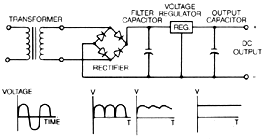
Power Supply Basics: 4 Types of Power Supplies
In its simplest definition, power supply is an electrical circuit that converts some form of energy into electrical energy, providing power to any electronic device. There are typically four types of power supplies:
- Unregulated Linear
- Regulated Linear
- Ferroresonant
- Switch Mode
The intrinsic differences between these four power supplies include size, weight, cost efficiency, voltage output, and ripple. In this two-part article series, we’ll look at how each one is different from the other and what are their features.
In part one of the Power Supply Basics series, we’re discussing regulated linear and unregulated linear power supplies.
Regulated and Unregulated Power Supply: How Are They Different?
The basic difference between a regulated and an unregulated power supply is the presence or absence of voltage regulation. In the case of regulated linear, the voltage is regulated, which means any change in the input voltage isn’t reflected in the output. On the contrary, unregulated power supplies do not have voltage regulation and for this reason, voltage is not regulated at the output.
Regulated Linear Power Supply

Voltage regulation in regulated power supplies refers to maintaining the voltage at the desired level. This is particularly suitable for sensitive connected appliances as regulated voltage provides a smooth, steady voltage supply.
The process of producing regulated voltage includes a series of sub-functions. First, the AC supply is stepped down to the desired output level, and then the reduced AC voltage is transformed into a positive waveform by a diode bridge rectifying circuit. A filter circuit comprising a parallel-connected capacitor turns the positive waveform into a rippled-DC voltage, and finally a regulator circuit eliminates the ripples in the DC to deliver stable voltage to the connected load.
Regulated linear power supplies are ideal for almost all types of electronic devices, as these power supplies ensure smooth supply of voltage.
Unregulated Linear Power Supply

As mentioned earlier and as the name suggests, regulation of voltage isn’t involved in an unregulated linear power supply. Apart from that, the basic functions of an unregulated power supply are similar to regulated linear power supplies. The AC input voltage, just like a regulated power supply, is initially processed and then transformed into rippled DC voltage through a filter capacitor. But since the unregulated power supplies don’t have a voltage regulator circuit, the ripples in the DC output voltage cannot be done away with. This leads to voltage sags, which are often reflected in the output.
Recap: Regulated Linear vs. Unregulated Linear Power Supplies
In short, regulated power supplies using a voltage regulator circuit, convert the AC main voltage into a clean, stable DC voltage without noise and variations. In contrast, an unregulated power supply provides a rippled-DC voltage by only rectifying the AC.
Key Differentials
Output Voltage
- Regulated – There is no variation in the output voltage of regulated power supplies irrespective of the current drawn by the load. The voltage is independent of the load current.
- Unregulated – The output voltage of unregulated power supplies changes with the output current, mainly because of the high internal resistance of the power supply.
Applications
- Regulated – Application areas of a regulated power supply include TVs, computers, and other highly sensitive electronic devices where voltage variations can be fatal.
- Unregulated – Electrical devices like LED lamps and DC motors that are not so sensitive to voltage fluctuations can use unregulated power supplies.
Cost
- Regulated – Regulated power supplies are comparatively expensive as they integrate voltage regulation circuits.
- Unregulated – Unregulated power supplies are low-priced due to fewer component requirements.
In part 2 of our Power Supply Basics series, we’ll discuss ferroresonant and switch mode power supplies.

